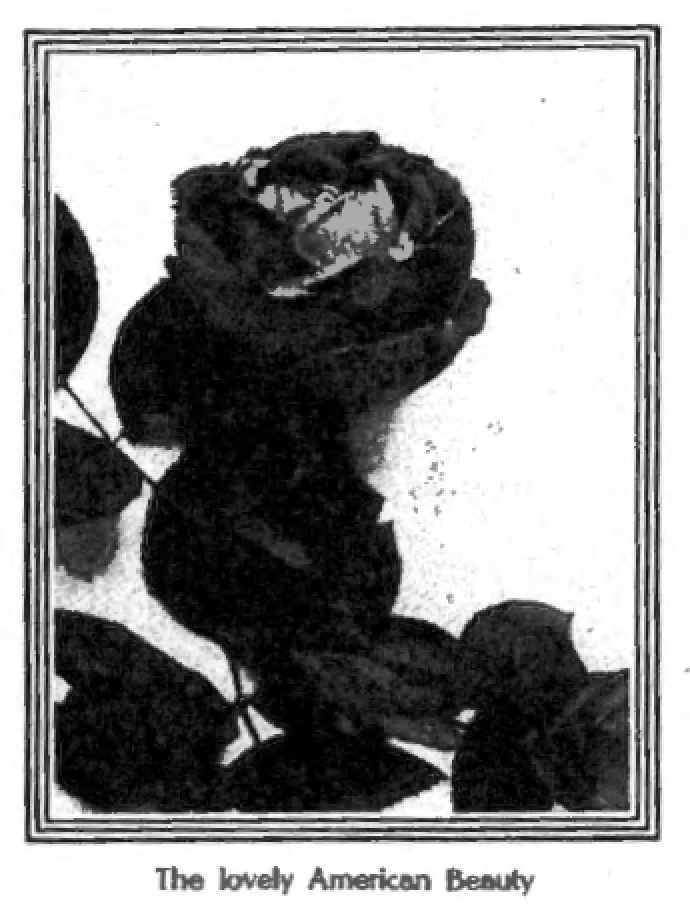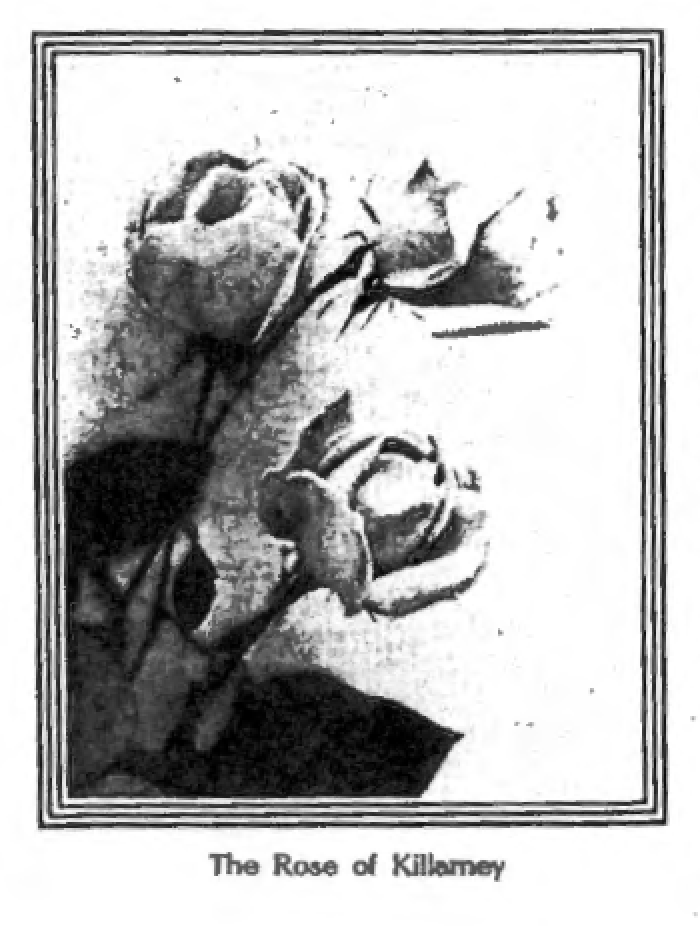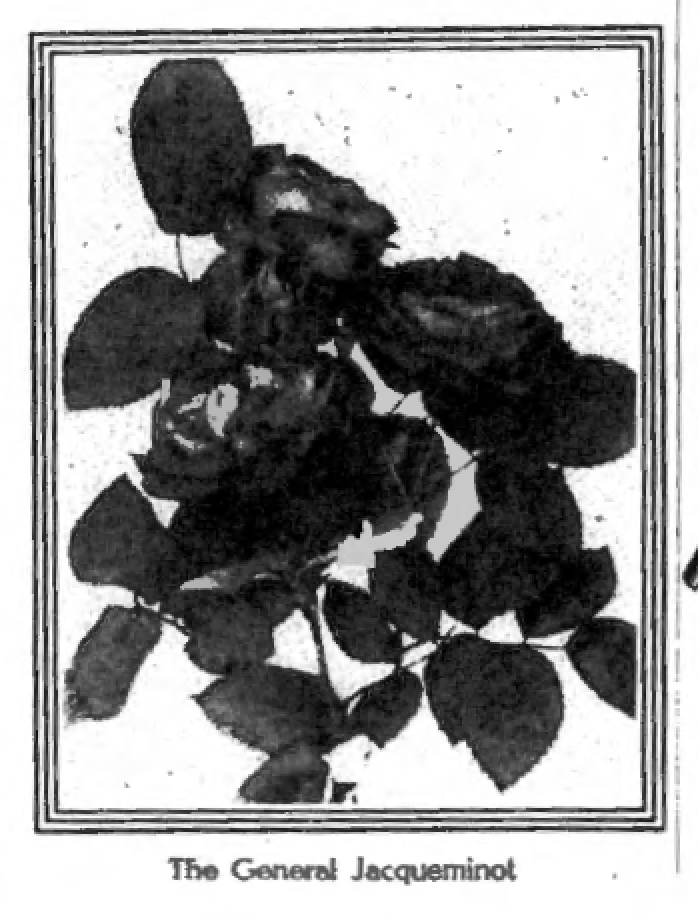|
The amateur does not often realize how long it takes a rose-garden, in which there are hardy perpetuals, ever-blooming roses and many climbers, to get sufficiently established for the blooms to appear in the full luxuriance which, in June, turns many a rosarium into a veritable fairy-land. Indeed, between a new rose-garden and one that is old and tried is a deal of difference. The new one instils a feeling of excitement, and a wonderment as to whether the bushes will fulfil the promises made for them, and give the pleasure their care and support demand. But an old rose-garden has already proved its promises. With the return of rose-time the trend of my days changes. I no longer breakfast at leisure, for there are roses to be picked and arranged. From the windows I have already seen the numbers that have unfolded since I visited them the twilight before. I allow no one else to pick my roses, and each one I know far better than do my friends. Invariably roses should be planted by themselves, for they thrive poorly unless allowed to absorb the entire nourishment of a rich soil. Indeed, many growers believe that certain varieties do best when living apart from even those nearest of kin, and make up their rosariums with many beds, each holding one kind of rose, or set the plants in rows with ample room left between for cultivation. June, however, is not the time to plan or build a rosarium, which can be done successfully only in the Spring or Autumn. It is still true that to the multitude a rose is a rose without other name or distinction. The American Beauty, however, is an exception to this rule, as are also the beautiful Brides’ and Bridesmaids’ roses. A few years ago the General Jacqueminot, under the familiar name of "Jack," also attained sufficient popularity to make it universally recognized. The Manon Cochet group, nevertheless, which are hardy enough to thrive in almost any garden, and bloom from June until the days of frost, are not beloved by the hundreds that might have them in their gardens as easily as they do geraniums. In late April they should be bought at a reliable nursery, planted, and then allowed to grow in peace. Manon Cochets occur in white, pink, and in yellow. They form a charming bed of the three colors, and are most attractive for cut flowers. The bushes, also, are well provided with foliage, so that their growing-place never has the bare look which seems inevitable when some varieties are out of bloom. A new rose in my garden this June is Madame Abel Chatenay, a hybrid tea-scented rose, reminding one, in the way its petals recurve, of the La France. In the bud it shows a deep rose-color, which gradually, as it opens, fades to a faint flesh-like salmon, most enchanting. The foliage does not grow very close to the blooms, but the stems are firm and strongly developed, so that they stand up well when arranged in vases. For these bushes two years old I paid fifty cents apiece, and have been delighted with the investment. The Souvenir de Pierre Notting is another tea-scented rose seen this June for the first time in my garden. It came to me in a so-called “collection of ten roses” offered by a nurseryman at an unusually small price. It was the only one on the list with which I was unacquainted, and through the perverse workings of fate it was the only one that lost its tag in transportation. I had a feeling of uncertainty about it, but planted it not far from the Kaiserin Augusta Victoria. I could not have found a better place since, now the buds are swollen, I see that they will show a soft, apricot yellow. It is always pleasing to add to my yellow roses, for they are not so numerous as those of other colors, and in some cases, as with the Perle des Jardins, more difficult to grow in a cold, uncertain climate. If the Maréchal Niel of old time fragrant aroma, could have a stem like that of the American Beauty, it would have rivaled it as a commercial success. In the Winter season American Beauties forced for the trade sell for twenty-four dollars a dozen, which the equally lovely blooms of Maréchal Niel would not command ten cents apiece. So does a tall sustaining stem enhance the value of a rose. In June the American Beauty becomes as imposing a feature of the rosarium as it is of the florist’s window in Winter. It belongs, also, among the ever-blooming hybrid tea roses, and its personality and remarkable fragrance are too familiar to need description. Those of my garden are now some six years old and appear in truth like large shrubs fairly covered with buds and partly-blown roses. Favorite roses, brilliantly red, are the Liberty and the Richmond. They begin to bloom early and continue until late in the Autumn. It would seem that there could be no purer, more vivid red than that of the Liberty rose, especially when the light shines through its petals. The Richmond is almost equally enchanting in color, though not perhaps of such an exquisitely delicate form. They both last well in water. In fact, for the decoration of certain rooms, especially those done in green, these brilliant roses are particularly effective. Among the hardy perpetuals of my garden none is blooming more freely this June than Madame Gabrielle Luizet. A bushel basket could easily be filled each morning with these roses of silvery-pink. This variety has been turned into a tree-rose by grafting it on an upright, hardy stem, and it is one of the most lovely. All are not successful with tree-roses, but with favorable climate and situation they give great style and charm as they outline the paths or stand at certain prominent points. Last year, early in June, I disbudded, for the first time, a few of my rose-bushes—that is, I set aside a number with the thought of going in for size of blooms rather than for numbers. On each one of the chosen I selected carefully two or three of the largest and most central buds, and then removed all the others. It seemed a cruel work, but later, when the buds I had spared unfolded, they were so remarkable in size and quality that they would have graced an exhibition of roses. Usually late in July or early August I take a number of cuttings from the ripened shoots of my roses. Some of them live and grow into strong bushes; other soon give up the struggle and die. I remove the cuttings at the point from which they grow out from the old wood, taking with them a slip of this older stock to form the "heel," as it is termed by professional gardeners. Then in a large pot filled with rich earth, leaf-mold and an abundance of silver sand I sink the cuttings to the depth of about an inch, packing closely, and supplying then freely with water. The next move is to set them in a shady, cool place until they have hardened. Afterward their rooting may be helped along by exposing them to the sun and inverting over them ordinary water-glasses. As soon as they have developed roots they should be transplanted into individual pots and again covered with the glasses until they appear hardy enough to continue their growth without assistance. Some seasons I have taken these young cuttings into the house over the Winter, and again, by November, they have become inured to the air and thrifty enough to be left out under Winter covering. I have more success with cuttings from hardy perennials than with the more delicate ever-blooming roses. Climbers and trailers have passed unhurt through the Winter. I have not added to their number this year; but in the coming Autumn, the best time for planting the hardy and hybrid perpetual roses, I shall hardly resist the temptation to set in a few more Dorothy Perkins and a Lady Gay. So June passes swiftly with the roses that now are aglow and the thoughts of those that are still to grow in my garden. The following usually prove satisfactory: Red, Hardy HybridHybrip Perpetual: Ulrich Brunner, Victor Verdier, General Jacqueminot, Prince Camille de Rohan, Tea and Hybrid Tea, Everblooming Helen Gould, Freiherr von Marschall, J. B. Clark. White roses, Hardy Hybrid Perpetual: Frau Karl Druschki, Margaret Dickson, Madame Plantier; Tea and Hybrid Tea: Kaiserin Augusta Victoria, White Maman Cochet and Marie Guillot are excellent. Pink roses, Hardy Hybrid Perpetual: Mrs. R. G. S. Crawford, Baroness Rothschild, Clio; Tea and Hybrid Tea: Killarney, La France, Pink Maman Cochet. Yellow roses, Hardy Hybrid Perpetual: Harrison’s Yellow, Soleil d’Or; Tea Roses: Marie Van Houtte, Souvenir de Pierre Notting, Yellow Maman Cochet, Etoile de Lyon. |


